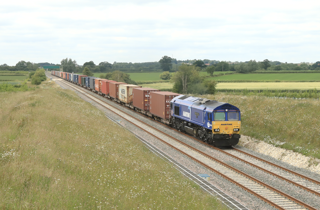Services on the West of England line between Salisbury and Exeter are being restored from November 15, following months of disruption.
Clay embankments had shrunk during the driest summer since 1936, causing tracks to become uneven (RAIL 965).
Network Rail imposed a speed restriction of 40mph between Tisbury and Gillingham in August. A further speed restriction was in place near Axminster.
NR said that repairs were futile until the shrinking stopped in late October, until rainfall returned to normal levels and the embankment stabilised sufficiently for the track to be realigned.
It meant that South Western Railway’s Class 159 diesels could only run at half the normal speed along much of the route.
And because this is a busy single-track line with limited passing places, each slow train also forced every service in the opposite direction to run late as well.
SWR’s solution was to reduce Exeter to just a two-hourly service, with one train an hour to Yeovil.
The Salisbury to Exeter Rail Users Group (SERUG) said it reduced the average speed on the long-distance route to only 32mph.
There are 6,000 clay embankments in the Southern region of Network Rail, extending to around 600 miles. The four-mile section near Tisbury is among the longest.
In August, Network Rail told RAIL that a permanent fix to make the region resilient to climate change would cost between £15 billion and £20bn and take decades. It said the number was so large, it could never happen.
The return to full service from November 15 will be brief. A further week-long engineering blockade of the line is due on December 10-18, when services between Salisbury and Exeter will be diverted via Westbury.
To read the full story, see RAIL 970.
You can subscribe for print/digital access via https://bit.ly/3DcPaAv
















Güntürk Üstün - 05/11/2022 21:38
South Western Railway (SWR), inherited a fleet of Classes 158, 159, 444, 450, 455, 456, 458 and 707 from South West Trains, and subsequently re-introduced Class 442 trains which had operated on Gatwick Express after earlier service with South West Trains. The current fleet for the Island Line, Class 484, entered service in November 2021. During March 2020, the Class 442 fleet was withdrawn; one year later, SWR decided that they would not be returned to service and their re-introduction has been cancelled. Classes 455, 456 and 707 fleets will be replaced by 30 five-car and 60 ten-car Class 701 units built at Bombardier's Derby Litchurch Lane Works, financed by ROSCO Rock Rail for £1 billion, for use on Reading, Windsor and London suburban services. Dr. Güntürk Üstün